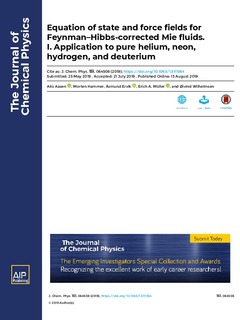| dc.description.abstract | We present a perturbation theory that combines the use of a third-order Barker–Henderson expansion of the Helmholtz energy with Miepotentials that include first- (Mie-FH1) and second-order (Mie-FH2) Feynman–Hibbs quantum corrections. The resulting equation of state, the statistical associating fluid theory for Mie potentials of variable range corrected for quantum effects (SAFT-VRQ-Mie), is compared to molecular simulations and is seen to reproduce the thermodynamic properties of generic Mie-FH1 and Mie-FH2 fluids accurately. SAFTVRQ Mie is exploited to obtain optimal parameters for the intermolecular potentials of neon, helium, deuterium, ortho-, para-, and normalhydrogen for the Mie-FH1 and Mie-FH2 formulations. For helium, hydrogen, and deuterium, the use of either the first- or second-order corrections yields significantly higher accuracy in the representation of supercritical densities, heat capacities, and speed of sounds when compared to classical Mie fluids, although the Mie-FH2 is slightly more accurate than Mie-FH1 for supercritical properties. The Mie-FH1 potential is recommended for most of the fluids since it yields a more accurate representation of the pure-component phase equilibria and extrapolates better to low temperatures. Notwithstanding, for helium, where the quantum effects are largest, we find that none of the potentials give an accurate representation of the entire phase envelope, and its thermodynamic properties are represented accurately only at temperatures above 20 K. Overall, supercritical heat capacities are well represented, with some deviations from experiments seen in the liquid phase region for helium and hydrogen. | nb_NO |

